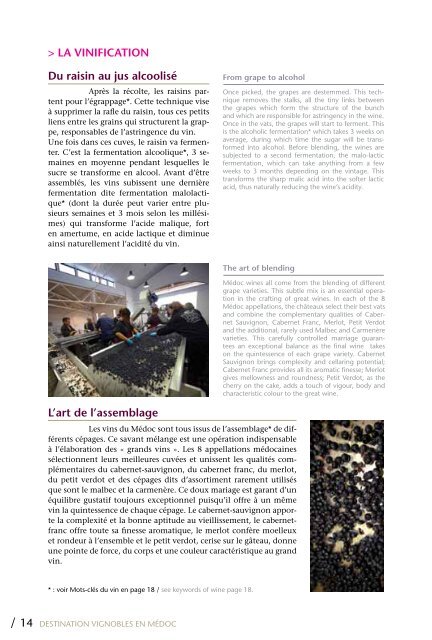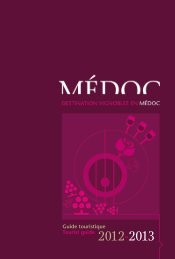Conseil des Vins du Médoc
Conseil des Vins du Médoc
Conseil des Vins du Médoc
Create successful ePaper yourself
Turn your PDF publications into a flip-book with our unique Google optimized e-Paper software.
LA VINIFICATIONDu raisin au jus alcooliséAprès la récolte, les raisins partentpour l’égrappage*. Cette technique viseà supprimer la rafle <strong>du</strong> raisin, tous ces petitsliens entre les grains qui structurent la grappe,responsables de l’astringence <strong>du</strong> vin.Une fois dans ces cuves, le raisin va fermenter.C’est la fermentation alcoolique*, 3 semainesen moyenne pendant lesquelles lesucre se transforme en alcool. Avant d’êtreassemblés, les vins subissent une dernièrefermentation dite fermentation malolactique*(dont la <strong>du</strong>rée peut varier entre plusieurssemaines et 3 mois selon les millésimes)qui transforme l’acide malique, forten amertume, en acide lactique et diminueainsi naturellement l’acidité <strong>du</strong> vin.From grape to alcoholOnce picked, the grapes are <strong>des</strong>temmed. This techniqueremoves the stalks, all the tiny links betweenthe grapes which form the structure of the bunchand which are responsible for astringency in the wine.Once in the vats, the grapes will start to ferment. Thisis the alcoholic fermentation* which takes 3 weeks onaverage, <strong>du</strong>ring which time the sugar will be transformedinto alcohol. Before blending, the wines aresubjected to a second fermentation, the malo-lacticfermentation, which can take anything from a fewweeks to 3 months depending on the vintage. Thistransforms the sharp malic acid into the softer lacticacid, thus naturally re<strong>du</strong>cing the wine’s acidity.L’art de l’assemblageThe art of blendingLes vins <strong>du</strong> Médoc sont tous issus de l’assemblage* de différentscépages. Ce savant mélange est une opération indispensableà l’élaboration <strong>des</strong> « grands vins ». Les 8 appellations médocainessélectionnent leurs meilleures cuvées et unissent les qualités complémentaires<strong>du</strong> cabernet-sauvignon, <strong>du</strong> cabernet franc, <strong>du</strong> merlot,<strong>du</strong> petit verdot et <strong>des</strong> cépages dits d’assortiment rarement utilisésque sont le malbec et la carmenère. Ce doux mariage est garant d’unéquilibre gustatif toujours exceptionnel puisqu’il offre à un mêmevin la quintessence de chaque cépage. Le cabernet-sauvignon apportela complexité et la bonne aptitude au vieillissement, le cabernetfrancoffre toute sa finesse aromatique, le merlot confère moelleuxet rondeur à l’ensemble et le petit verdot, cerise sur le gâteau, donneune pointe de force, <strong>du</strong> corps et une couleur caractéristique au grandvin.Médoc wines all come from the blending of differentgrape varieties. This subtle mix is an essential operationin the crafting of great wines. In each of the 8Médoc appellations, the châteaux select their best vatsand combine the complementary qualities of CabernetSauvignon, Cabernet Franc, Merlot, Petit Verdotand the additional, rarely used Malbec and Carmenèrevarieties. This carefully controlled marriage guaranteesan exceptional balance as the final wine takeson the quintessence of each grape variety. CabernetSauvignon brings complexity and cellaring potential;Cabernet Franc provi<strong>des</strong> all its aromatic finesse; Merlotgives mellowness and roundness; Petit Verdot, as thecherry on the cake, adds a touch of vigour, body andcharacteristic colour to the great wine.* : voir Mots-clés <strong>du</strong> vin en page 18 / see keywords of wine page 18./ 14 DESTINATION VIGNOBLES EN MÉDOC



